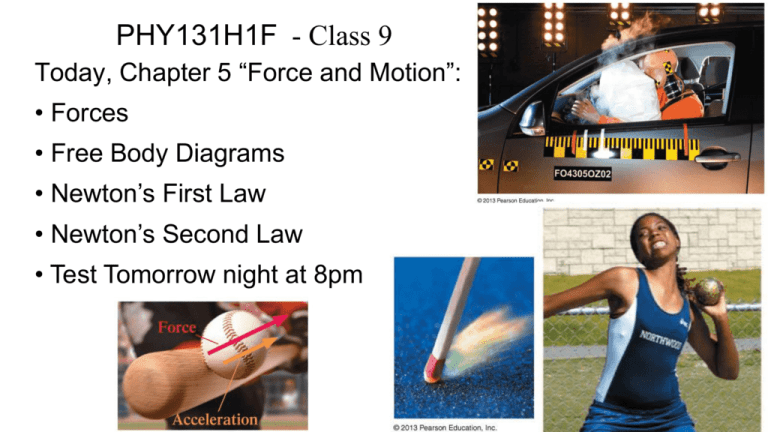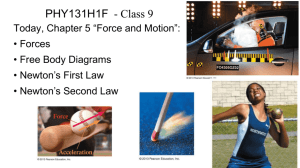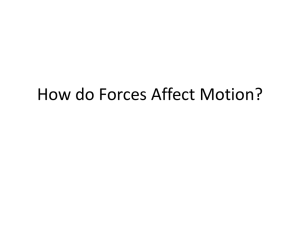PPTX
advertisement

PHY131H1F - Class 9 Today, Chapter 5 “Force and Motion”: • Forces • Free Body Diagrams • Newton’s First Law • Newton’s Second Law • Test Tomorrow night at 8pm Clicker Question 1 • You toss a ball straight up in the air. • Immediately after you let go of it, what forces are acting on the ball? 1. The downward force of gravity from the Earth. 2. An upward throwing force from your hand. 3. A small downward drag-force from air resistance. A. B. C. D. E. 1, 2 and 3 1 and 3 1 and 2 1 only 2 and 3 Class 9 Preclass Quiz on MasteringPhysics This was due this morning at 8:00am 859 students submitted the quiz on time 57% of students answered correctly: An inertial reference frame is one in which Newton’s Laws are valid 93% of students answered correctly: The net force is the vector sum of all forces acting on a particular object. 82% of students answered correctly: doubling the mass for the same net force means acceleration is half as much. 82% of students answered correctly: When a body is in dynamic equilibrium, the net force acting on the body is zero. Class 9 Preclass Quiz on MasteringPhysics Some common or interesting student comments/feedback: Inertial Frames of reference – lots of questions/comments about this Free body diagrams - lots of questions/comments about this “I found Newton to be the most interesting because he came up with three laws which revolutionized the world of physics.” “Newton is da bomb.” “It was interesting how all the types of forces are clearly present in our daily lives.” “May the force be with you...during the midterm.” “May the ‘mass times acceleration’ be with you ” “What's more interesting is the fact that I still haven't been featured on the power point... I used to think I was funny...” Class 9 Preclass Quiz on MasteringPhysics “For the ball in the airplane example of inertial reference frame, if I stick the ball on the airplane's floor so that the ball does not move even the airplane accelerates, can I say that the airplane is an inertial reference frame of the ball?” No. In an inertial reference frame, you wouldn’t need glue sticking you to the floor to keep you from accelerating away. Problem Set 3 on MasteringPhysics This was due last night at 11:59pm 848 students did the problem set by the deadline It took an average of 1 hour and 19 minutes for students to complete the problem set The average for the 929 students who submitted on time was 96.8%. The most difficult problem seemed to be “A Canoe on a River” 𝑣𝑟/𝑒 𝑣𝑐/𝑒 = 𝑣𝑐/𝑟 + 𝑣𝑟/𝑒 𝑣𝑐/𝑒 𝑣𝑐/𝑟 Last day I asked at the end of class: • A paperback novel has a mass of 0.3 kg and slides at a constant velocity. A physics textbook has a mass of 3.0 kg, and slides at the same constant velocity. How does the net force on the textbook compare to the net force on the novel? • ANSWER: SAME: zero! • The net force on any object is proportional to its acceleration. • In the case of these two books, they are both traveling at a constant velocity, meaning acceleration is zero. • Any friction must be offset by some pushing force, not mentioned in the question. Isaac Newton • Born in 1643, the year Galileo died. • Was a “physicist, mathematician, astronomer, natural philosopher, alchemist, and theologian and one of the most influential people in human history.” (http://en.wikipedia.org/wiki/Isaac_Newton) • In Philosophiæ Naturalis Principia Mathematica, published 1687, he described universal gravitation and the three laws of motion, laying the groundwork for classical mechanics. Clicker Question 2 • You are in a plane which is accelerating forward on a runway. • Some careless person has left a tennis ball in the aisle. You notice this tennis ball is accelerating toward the back of the plane. • Newton’s Second Law states that Fnet = ma, so there must be a net force on the tennis ball. What is the source of this backward net force? A. Air resistance B. The plane must be at an angle, so a component of gravity provides the net force toward the back of the plane. C. The inertial force D. The normal force E. Newton’s second law is not valid in your reference frame. What is a force? • A force is a push or a pull on an object. • A force is a vector. It has both a magnitude and a direction. • A force requires an agent and a recipient. Something does the pushing or pulling, and something else gets pushed or pulled. • A force is either a contact force (like normal) or a long-range force (like gravity). • The S.I. unit of force is the Newton (N) • N is not a fundamental unit; it can be broken down into fundamental units: Tactics: Drawing force vectors A Short Catalog of Forces The 5 forces we deal with most often in PHY131 are: 1. Gravity (Fg = mg) 2. Normal Force 3. Tension 4. Kinetic Friction ( fk = μkn) 5. Static Friction …plus there are others which come up less frequently, such as: spring force, drag (a.k.a. air resistance), rolling friction, thrust, the electric force, the magnetic force Gravity FG mg FG “The Earth exerts a gravity force on the angry bird.” Normal Force “The diving board exerts a normal force on the dog.” Tension “The rope exerts a tension force on Harlow.” Kinetic Friction “The ground exerts a kinetic friction force on Suleyman.” where n is the magnitude of the normal force, and μk is a constant, which happens to be low for plastic on snow. Static Friction “The ground exerts a static friction force on the shoe.” Clicker Question 3 • A car is parked on flat, horizontal pavement. • Which of the following forces are acting on the car? A.Gravity B.Normal C.Static friction D.Both A and B E.A, B and C Clicker Question 4 The Net Force • A car is parked on flat, horizontal pavement. • The “net force” is the vector sum of all the forces on the car. • What is the direction of the net force on the car? A. Up B. Down C. The net force is zero Midterm Test 1 • Tuesday, October 8, from 8:00pm to 9:30pm. Tomorrow! • The test will actually begin at 8:10pm and last for 80 minutes; please arrive 10 minutes early if you can, so you can get settled • This test will count for 15% of your mark in the course • There will be no make-up for this test. Students who miss a test for legitimate and documented reasons will have the weight of the test transferred to the other test which will then count for 30% of their course mark • You must go to the correct room in EX or HA, based on your Practical Group • Your practical group is the one that shows under the "My PRA groups" link on the Portal “Which room am I in on Tuesday at 8:00pm?” • EX = Exam Centre, 255 McCaul St. • HA = Haultain Building, 170 College St. Midterm Test 1 • The test will have: 8 multiple-choice questions Three long-answer problems counting for a total of 16 marks, which will be graded in detail; part marks may be awarded, but only if you show your work. • Please bring: Your student card. A calculator without any communication capability. A pencil with an eraser. A single, original, handwritten 8 1/2 × 11 inch sheet of paper on which you may have written anything you wish, on both sides. Midterm Test 1 - hints • Don’t be late. If you’re very early, just wait outside the room. • Spend the first 2 or 3 minutes skimming over the entire test from front to back before you begin. Look for the easy problems that you have confidence to solve first. • Before you answer anything, read the question very carefully. The most common mistake is misreading the question! • Manage your time; if you own a watch, bring it. 10 problems over 80 minutes means an average of 8 minutes per problem. • You CANNOT HAVE YOUR PHONE with you at a test or exam at U of T – you must store it in your bag at the edge of the room, at least 3 m away from you Midterm Test 1 – more hints! • Some of the multiple choice are conceptual and can be answered in less than 2 minutes.. Maybe do these ones first? • If you start a longer problem but can't finish it within about 10 minutes, leave it, make a mark on the edge of the paper beside it, and come back to it after you have solved all the easier problems. • When you are in a hurry and your hand is not steady, you can make little mistakes; if there is time, do the calculation twice and obtain agreement. • Bring a snack or drink. • Don't leave a test early! You might spend the first half getting 95% of the marks you're going to get, and the second half getting the other 5%, but it's still worth it. Little survey: How are you feeling about the test tomorrow? A. I feel confident about the test tomorrow; I believe I will get an A B. I’m not too sure what to expect, but I’m hopeful I’ll do well C. I have no particularly positive or negative feelings about the test tomorrow.. D. I’m not too sure what to expect, but I’m worried it will be awful E. I am very worried about the test tomorrow; I’m afraid I’m going to fail! The Fundamental Forces of Nature There are four fundamental forces in nature: 1. Gravity 2. Electromagnetism 3. Weak Nuclear Force 4. Strong Nuclear Force • Gravity is always attractive, and acts between any two objects. • Electromagnetism causes repulsion and attraction between charged particles, such as the protons and electrons in matter. This gives rise to almost all of the forces we deal with in PHY131/132: Normal, Tension, etc. • Weak and Strong Nuclear forces are important in understanding how atomic nuclei are held together and certain forms of radiation – not important for PHY131/132. 1 Newton’s First Law The natural state of an object with no net external force on it is to either remain at rest or continue to move in a straight line with a constant velocity. What is Mass? • Mass is a scalar quantity that describes an object’s inertia. • It describes the amount of matter in an object. • Mass is an intrinsic property of an object. • It tells us something about the object, regardless of where the object is, what it’s doing, or whatever forces may be acting on it. 2 Newton’s Second Law The acceleration of an object is directly proportional to the net force acting on it, and inversely proportional to its mass. Fnet a m Clicker Question 5 A fan attached to a cart causes it to accelerate at 2 m/s2. Suppose the same fan is attached to a second cart with smaller mass. The mass of the second cart plus fan is half the mass of the first cart plus fan. The acceleration of the second cart is A. 16 m/s2. B. 8 m/s2. C. 4 m/s2. D. 2 m/s2. E. 1 m/s2. Projectile Motion Example • An angry bird of mass m = 0.12 kg is flying through the air. His wings are tucked in, and air resistance is negligible. • What is the acceleration of the bird? Clicker Question 6 Three forces act on an object. In which direction does the object accelerate? Mass on Frictionless Inclined Plane Example • A cart of mass m = 0.195 kg is rolling on a track that is inclined at an angle θ above the horizontal. Friction is negligible. • What is the acceleration of the cart? θ Problem Solving Strategy • Acceleration is the link between dynamics and kinematics. • From Fnet, find a. • From a and initial conditions, find vx, vy, x, y. • a = 0 is the condition for equilibrium. • “static equilibrium” is when a = 0 and v = 0. • “dynamic equilibrium” is when a = 0 and v ≠ 0. • Equilibrium occurs if and only if Fnet = 0. Clicker Question 7 • A green ball swings back and forth between positions 1, 2 and 3. Fg is the magnitude of the force of gravity on the ball. T is the magnitude of the tension force on the ball. At the instant the ball is in position 2, A. Fg > T B. Fg < T C. Fg = T Before Class 10 on Wednesday • Please read Chapter 6 of Knight, sections 6.1 through 6.3. • Something to think about: • When astronauts are floating in a space station, are they really weightless? Have you seen Canadian Astronaut Chris Hadfield singing a revised version of David Bowie’s “Space Oddity” on the International Space Station? http://youtu.be/KaOC9danxNo .





